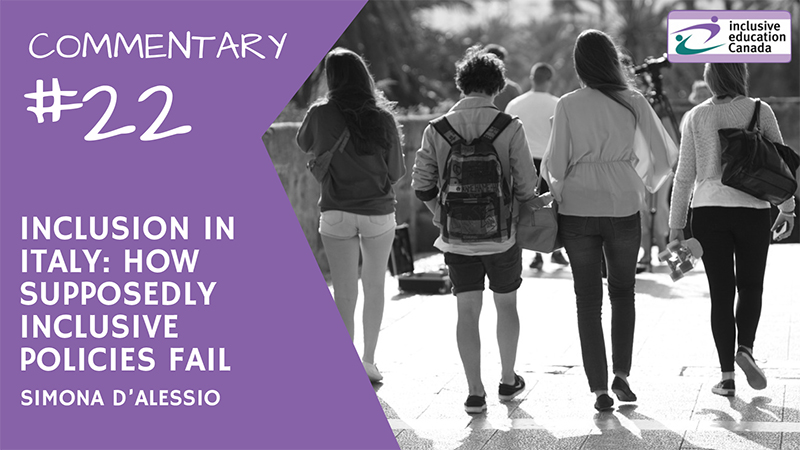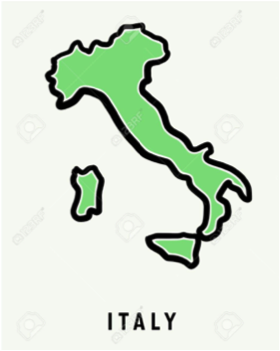 National Inclusive Education Month Commentary #22
National Inclusive Education Month Commentary #22
By Simona D’Alessio, Ph.D., Educator and Researcher, Rome, Italy
Educational policies voice political preferences of government on power. Jones (2013) identifies four main political orientations for educational policies, which include conservative, liberal, critical and finally post-modern positions, each one pursuing different goals. When examining policy, analysts need to critically investigate what is said, but also what goes unsaid. Do policies produce results beyond declared intentions? In addition, policy is not just made by governments (top-down approach) and implemented at a school level. Policy is often the result of the struggle between community stakeholders, the local officials, parents and teachers who live with education policy day-to-day. This is certainly true of policy on inclusion in education.
Italy is internationally known for the milestone policy of integrazione scolastica or school integration, passed in 1992. It ratified the education of disabled learners in regular, mainstream classrooms with their non-disabled peers, which began in 1971. For decades, Italy was dismantling its separate institutions and special schools whilst the rest of the world was struggling with what to do about special education and how to end segregation in special schools. In Italy segregated schools were considered a crime against human rights.
Inclusion in education is a challenge to the operation of the school system. Systems must be put in place to enable students with disabilities to attend their local school, where they are provided with additional resources and staff as needed (see D’Alessio, 2009, 2011; D’Alessio and Cowan, 2013). Authorities must provide funding for specialist teachers and technological devices and other learning tools (e.g. Braille keyboard; laptops) in each school. Personalization of teaching and learning must be provided via individualized educational plans (IEPs) for students who need support.
Until recently, Italy has been one of the few countries that has not ‘surrendered’ to the Anglo-Saxon classification of ‘special educational needs’ to identify students at risk of school failure. Despite this history, the Italian Ministry of Education recently decided to create a macro-category of learners, specifically students ‘with special educational needs’ (SEN henceforward).
In 2013 the Ministry had to pass a series of policies and guidelines to tell schools what the changes meant and what the schools were supposed to do in practice. Arguably, all these policies were intended to promote change towards inclusive education by supposedly making school settings more responsive to the diversity of the whole student population. However, it is now clear that there are serious questions about whether the SEN policies are contributing to the development of inclusion. Critics suggest that the new approach does not require the education system to adequately meet the challenge of some students and can thus remain unaltered.
The new Italian macro-category of SEN includes three sub-categories of need:
- Learners with severe physical or intellectual impairments diagnosed by the local health units and according to the school integration policy (or Framework Law 104/1992);
- Learners with learning difficulties, such as dyslexia and dyscalculia, certified by a public or private clinical diagnosis according to the Law 170/2010;
- Learners with cultural, linguistic and socio-economic disadvantages, who are identified according to the new SEN directives and policies.
Such a three-level categorization system, however, foresees different types of provision for learners: whilst the first sub-category of SEN students is entitled to additional provision and funding (i.e. supplementary aids and specialist teachers), the second and third categories are instead only entitled to receive individual approaches to learning, which may include compensatory or dispensatory measures put in place by class teachers. To put it simply, extra funding and specialist school staff are not provided to the schools for the second and third sub-categories of students.
 In 2017, the Left-Wing Government passed a school reform known as the ‘Buona Scuola’ (the good school). In April 2017, a new legislative measure was passed (Decree n.66) to provide clear indications on the inclusion of students with disabilities in regular classrooms within the new reform. Within this new Decree inclusion is defined as a process, which is specifically related to the education of students (boys and girls) whose educational needs are different from those of ordinary students. Inclusion is also described as a condition that can be achieved through the implementation of different educational and didactical strategies aiming at developing individual’s potentials and at fostering students’ rights to self-determination and to reasonable accommodations.
In 2017, the Left-Wing Government passed a school reform known as the ‘Buona Scuola’ (the good school). In April 2017, a new legislative measure was passed (Decree n.66) to provide clear indications on the inclusion of students with disabilities in regular classrooms within the new reform. Within this new Decree inclusion is defined as a process, which is specifically related to the education of students (boys and girls) whose educational needs are different from those of ordinary students. Inclusion is also described as a condition that can be achieved through the implementation of different educational and didactical strategies aiming at developing individual’s potentials and at fostering students’ rights to self-determination and to reasonable accommodations.
The Decree is to be applied, however, only to those children who possess a statement of SEN according to Law 104/1992 (Art. 2), the first sub-category of students discussed above. The Decree also establishes that assessment procedures are to be carried out using the International Classification of Functioning Disability and Health (WHO, 2001). Because of the adoption of this new manual, a multi-disciplinary commission ascertains the functional profile of the child with disabilities, in collaboration with the parents and a representative from the school that the child attends.
At first glance, these SEN policies seem to support the development of inclusive education as they ensure that individual support is provided to those students who have been identified as having special educational needs and/or with disabilities. However, when looking at these policies from an inclusive perspective, a series of questions need to be asked:
- What does inclusive education mean in practice?
- What is the difference between inclusive education and special needs education?
- Are these new special educational needs policies leading to inclusive education in Italy?
- Is inclusion fundamentally about educating children with special educational needs and disabilities in common learning environments and about providing them with appropriate specialist assistance?
- Is it about allowing them to progress against the learning targets identified within individual educational plans?
Identifying and labeling some students as SEN is a necessary step to provide them with the extra support they need to achieve in the mainstream classroom. Some of us, however, believe that inclusive education is more than ensuring placement and additional support to individual students. Although the identification procedures by which some students are classified as having special educational needs and disabilities gives way to a series of additional provision and specialist support, they nevertheless reinforce the stigmatization of difference in education and the idea that some students are ‘in need’ because they lack something. The focus remains on their functioning against an established norm (never challenged) and what is not working within them, while the education system remains mostly unchanged.
Some of us believe that inclusive education is about changing the way in which regular schools are currently structured. Inclusion goes beyond including former marginalized minorities into mainstream settings. It encapsulates the process of making education systems responsive to the entire student population. Inclusive policies should address what needs to be changed in attitudes, pedagogy, curriculum, assessment and school organization. They need to ensure that barriers are identified and removed. It is about instructional improvement including the use of universal design for learning. Schools and teachers need to ensure that all students, including those identified as having special educational needs and disabilities, can benefit from being educated in common learning environments along with their peers.
Italy’s new policies on special educational needs have failed to set out the next steps in developing inclusive education. It is not enough to allow students identified as having SEN to access additional funding and supplementary aids and staff in mainstream settings. Creating inclusive schools is about ensuring that all state schools have a budget to function effectively as they ensure that curriculum, pedagogy, organization and assessment are made inclusive.
Italy’s new SEN macro-category policy does finally bring justice for all those learners who are experiencing school failure. However, it also puts the emphasis on functioning against an established norm and determining what is not working within the student, rather than focusing on systemic barriers to learning. More and more students are now being identified, classified and categorized as being SEN.
SEN policies in Italy are basically reinforcing discriminatory discourses such as ableism (the disabled/SEN versus the ideal/ordinary student) and disablism (student difference is perceived as a form of inferiority and pathology against a dominant view of what normality is). These divisive discourses focus on the diversity of the individual and enhance specialized programs (IEPs), use of specialist teachers as well as external professionals. If critical policies are meant to promote systemic change, then it is time that policies to promote inclusion identify the ways in which schools can be changed to address the needs of all students, not because of a “special need” or medical diagnosis, but because each of them has a right to a quality education.
Some of us believe that it is time to develop and enact transformative inclusive policies that challenge education systems and schools to become inclusive learning communities.
References:
D’Alessio, S. (2011) Inclusive Education in Italy. A Critical Analysis of the Policy of Integrazione Scolastica. Rotterdam: Sense Publishers
D’Alessio, S., (2009), L’intégration scolaire en Italie. Quelques réflexions pour le développement de l’éducation inclusive in La nouvelle revue de l’adaptation et de la scolarisation. IN SHEA Revue, Edition Spécial, 2009/2010, Suresnes, France (pp. 35-65)
D’Alessio S., and Cowan, S., (2013) Cross-cultural approaches to the study of ‘inclusive education’ and ‘special needs’ education in Annual Review of Comparative and International Education in International Perspectives on Education and Society (IPES) Series, Vol. 23. PA, US
Jones, T., (2013) Understanding education policy. The ‘Four Orientations Framework’. Springer Briefs in Education
 Simona D’Alessio, Ph.D. is a researcher in inclusive education and a former specialist teacher. She is currently working as an SEN/Inclusion Inspector for KHDA (UAE) and is an Honorary Fellow Researcher for the Institute of Education, UCL (UK). Email Simona at: simonadalessio@yahoo.it
Simona D’Alessio, Ph.D. is a researcher in inclusive education and a former specialist teacher. She is currently working as an SEN/Inclusion Inspector for KHDA (UAE) and is an Honorary Fellow Researcher for the Institute of Education, UCL (UK). Email Simona at: simonadalessio@yahoo.it
